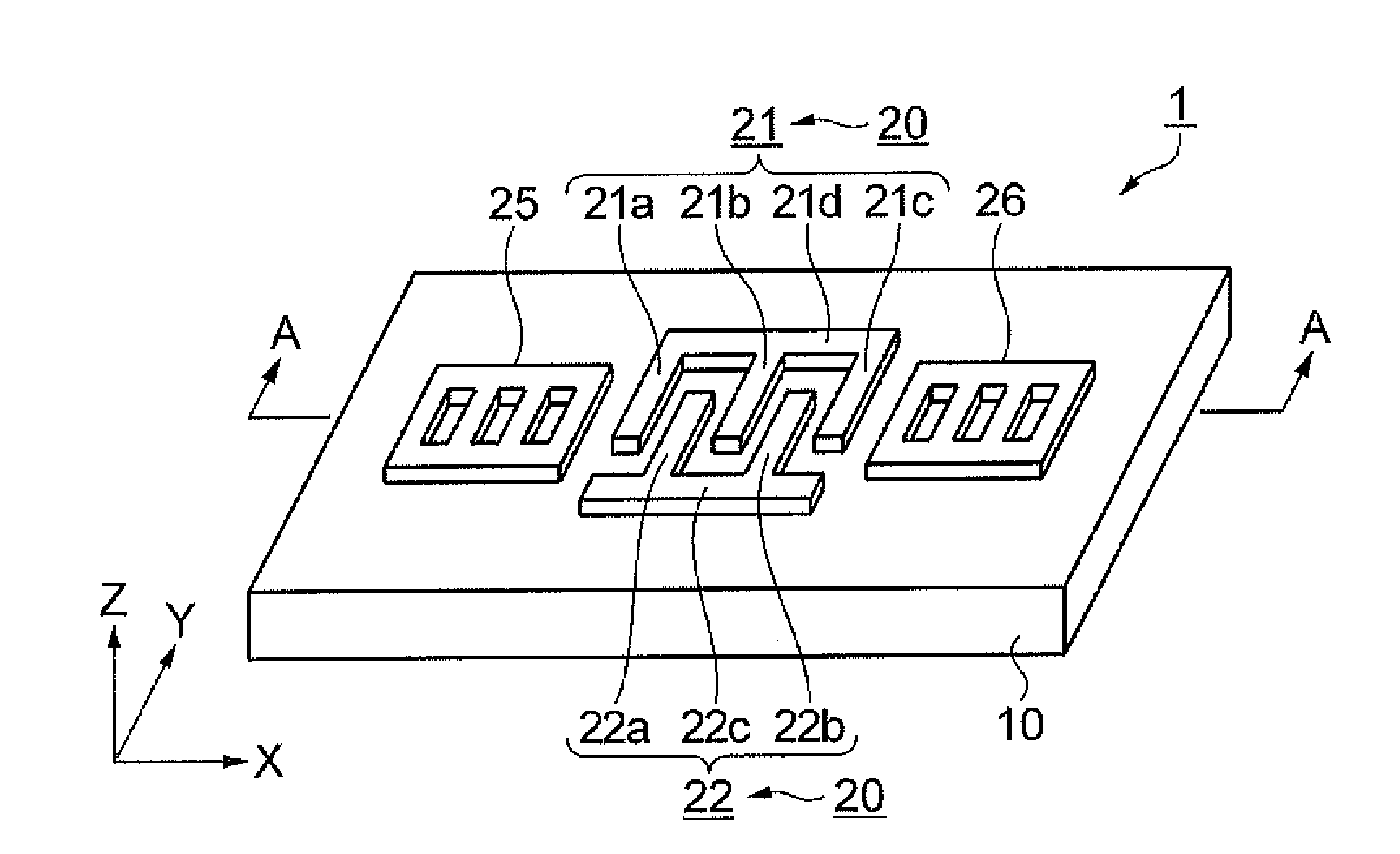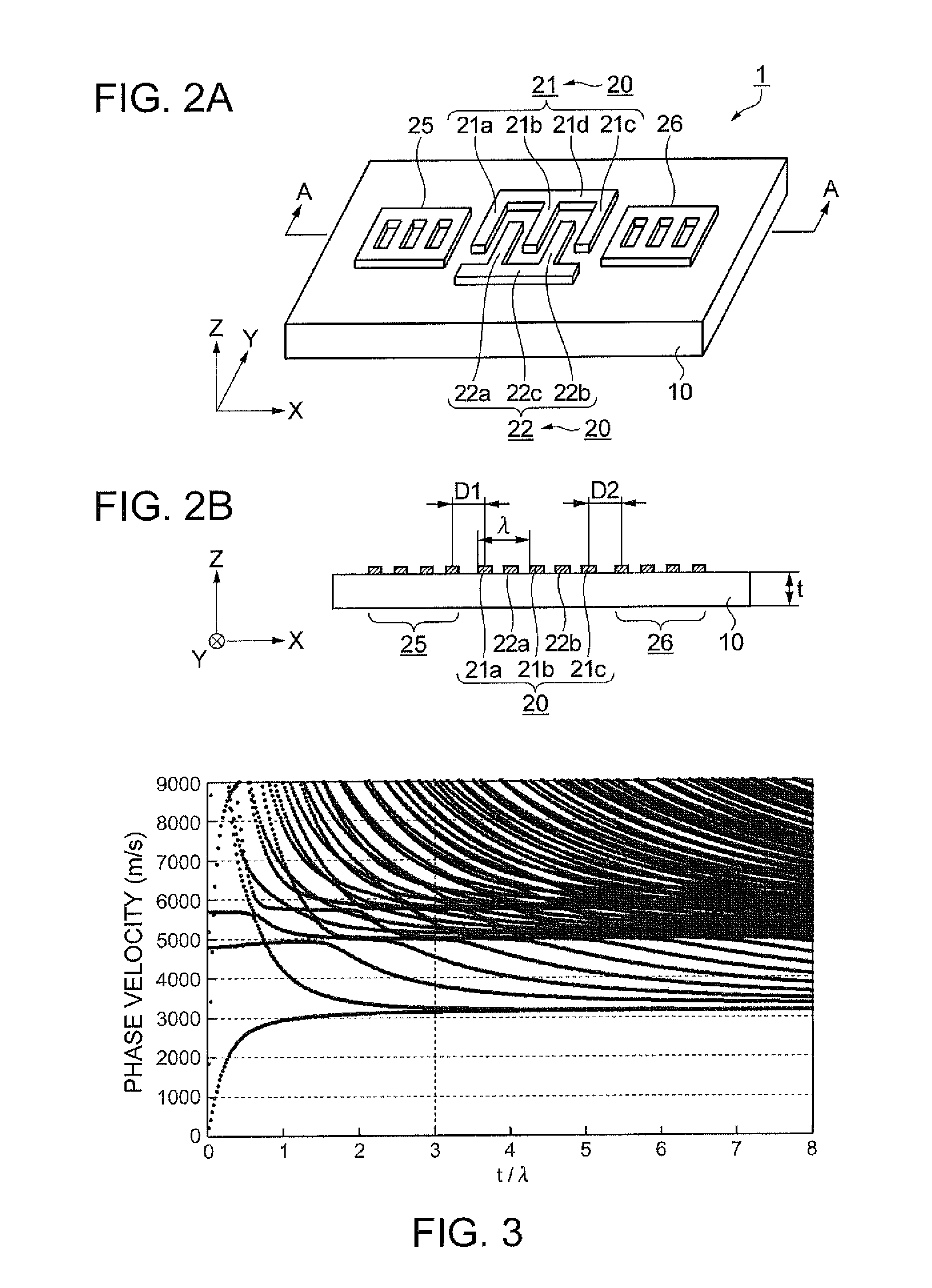Lamb-wave resonator and oscillator
a resonator and oscillator technology, applied in the direction of oscillator, impedence network, electrical apparatus, etc., can solve the problems of not revealing specific measures to enhance energy trapping in the widthwise direction, difficult to take full advantage of preferable characteristics, and difficult to say that this electrode design is true, etc., to achieve superior frequency temperature characteristic, low ci value, and high q-value
- Summary
- Abstract
- Description
- Claims
- Application Information
AI Technical Summary
Benefits of technology
Problems solved by technology
Method used
Image
Examples
embodiment
[0053]FIG. 1 is an explanatory diagram showing an azimuth direction in which a quartz substrate is cut out and a direction in which a Lamb wave propagates according to the present embodiment, namely an explanatory diagram of the Euler angles (φ, θ, ψ). The azimuth direction in which the quartz substrate 10 as a piezoelectric substrate is cut out is defined by an X axis called an electrical axis, a Y axis called a mechanical axis, and a Z axis called an optical axis.
[0054]The quartz substrate 10 expressed by the Euler angles (0°, 0°, 0°) forms a Z-cut substrate having a main surface perpendicular to the Z axis. Here, the angle φ in the Euler angles relates to a first rotation of the Z-cut substrate, and represents a first rotation angle assuming that the Z axis is a rotation axis, and the rotation angle in a rotational direction from +X axis to +Y axis is a positive rotation angle.
[0055]The angle θ of the Euler angles relates to a second rotation performed subsequently to the first r...
example 1
[0088]FIGS. 5A through 5C are explanatory diagrams showing a calculation result according to Example 1. In the Example 1, there is shown the case of arranging the Euler angles (0°, 42.0°, 0°), Wi=30λ, Wg=2.0λ, and Wb=28.0λ as an example, and FIG. 5A shows the widthwise displacement distribution of the quartz substrate in the resonant state in the case of arranging the quartz substrate to have an even thickness.
[0089]As shown in FIG. 5A, the displacement becomes the maximum at the center (on the center line P) of the IDT electrode. However, in the areas outside the apposition width Wi and reaching the free surface, the widthwise displacement does not converge, but the displacement in the outer ends of the quartz substrate in the widthwise direction becomes larger. In other words, it shows that the energy is not trapped because of the occurrence of the vibration leakage.
[0090]The occurrence of the vibration leakage to the free surface causes loss of energy, drop of the Q-value as an i...
example 2
[0099]FIGS. 6A through 6C are explanatory diagrams showing a calculation result according to Example 2. In the Example 2, there is shown the case of arranging the Euler angles (0°, 42.0°, 0°), Wi=20λ, Wg=6.0λ, and Wb=30.0λ as an example, and FIG. 6A shows the widthwise displacement distribution of the quartz substrate in the resonant state in the case of arranging the quartz substrate to have an even thickness.
[0100]As shown in FIG. 6A, in the case of arranging the thickness of the quartz substrate to be even, the widthwise displacement does not converge in the area outside the apposition width Wi and reaching the free surface, and the displacement in the outer ends of the quartz substrate in the widthwise direction becomes larger. In other words, it shows that the energy is not trapped because of the occurrence of the vibration leakage.
[0101]FIG. 6B shows the case of arranging the thickness tg in the gap area (Wg) of the quartz substrate to be smaller than the thickness ti thereof ...
PUM
 Login to View More
Login to View More Abstract
Description
Claims
Application Information
 Login to View More
Login to View More - R&D
- Intellectual Property
- Life Sciences
- Materials
- Tech Scout
- Unparalleled Data Quality
- Higher Quality Content
- 60% Fewer Hallucinations
Browse by: Latest US Patents, China's latest patents, Technical Efficacy Thesaurus, Application Domain, Technology Topic, Popular Technical Reports.
© 2025 PatSnap. All rights reserved.Legal|Privacy policy|Modern Slavery Act Transparency Statement|Sitemap|About US| Contact US: help@patsnap.com



